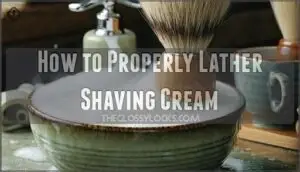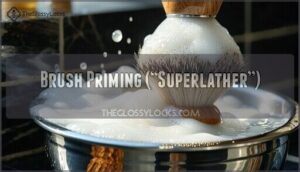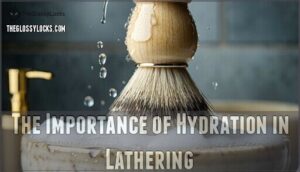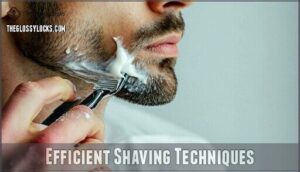This site is supported by our readers. We may earn a commission, at no cost to you, if you purchase through links.
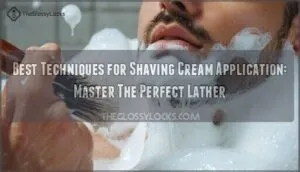
Wet your face with warm water to soften whiskers and open pores.
Apply a dime-sized amount of cream to your palm or shaving brush.
Work it into a rich lather using circular motions.
Spread the cream evenly across your shaving area, ensuring complete coverage.
Don’t rush this step – proper application creates a protective barrier between your razor and skin.
Use upward strokes to lift hair follicles for easier cutting.
Let the cream sit for thirty seconds to fully hydrate your whiskers.
The magic happens when you understand how different skin types respond to various application methods, which is key to successful shaving.
Table Of Contents
- Key Takeaways
- Picking The Right Shaving Tool
- Applying Shaving Cream: Techniques and Tips
- Understanding The Lathering Concept
- Time for Shaving Cream Activation
- Efficient Shaving Techniques
- Post-Shave Care and Hygiene for Shaving Tools
- Frequently Asked Questions (FAQs)
- How do you use a shave cream?
- Should you use shaving cream?
- How do you use a shaving cream if you have sensitive skin?
- How do you make shaving cream smoother?
- How do you apply shaving cream to your brush?
- How do you prepare to shave a face?
- How do you shave your neck without getting razor bumps?
- Can you exfoliate and shave on the same day?
- How do you shave properly?
- What is the shaving foam trick?
- Conclusion
Key Takeaways
- Prepare your skin properly – Wet your face with warm water to soften whiskers and open pores before applying a dime-sized amount of cream using circular motions for complete coverage.
- Let the cream activate – Do not rush to shave immediately after application; let the cream sit for 30-60 seconds to penetrate hair follicles and create a protective barrier that will prevent irritation.
- Master your lathering technique – Use a quality shaving brush with natural bristles and work the cream into a rich lather through consistent circular motions, adjusting water temperature and cream quantity for your skin type.
- Follow proper shaving direction – Always shave with the grain using gentle strokes and short passes, especially on sensitive areas, while keeping your skin taut and rinsing your blade frequently for the smoothest results.
Picking The Right Shaving Tool
When choosing your shaving arsenal, you’re setting the foundation for exceptional results.
Your razor selection matters more than you might think.
Disposable razors offer convenience and safety for beginners, while safety razors provide superior blade sharpness and control.
Straight razors deliver the closest shave but demand skill and patience.
Handle ergonomics shouldn’t be overlooked.
A comfortable grip prevents accidents and reduces hand fatigue during longer shaving sessions.
Consider your skin sensitivity when selecting razor types.
Sensitive skin benefits from single-blade options over multi-blade cartridges.
Many users explore different shaving razor options to find the best fit.
Don’t forget essential shaving cream tools.
A quality shaving brush with natural bristles lifts hair and creates superior lather.
Pair it with a shaving bowl for convenient mixing.
These shaving tools work together seamlessly.
Tool maintenance extends your equipment’s lifespan.
Rinse blades after each use and store them in dry conditions.
Replace dull blades promptly to prevent irritation and nicks.
Applying Shaving Cream: Techniques and Tips
Getting the right amount of shaving cream and spreading it evenly makes the difference between a smooth shave and razor burn.
You’ll learn the exact techniques that create perfect lather coverage while protecting your skin from nicks and irritation.
How to Properly Lather Shaving Cream
Now that you’ve selected your ideal shaving tool, mastering perfect lather becomes your next priority.
Creating exceptional shaving cream lather requires attention to four key elements:
- Brush Type – Natural bristles retain water better for superior lathering techniques
- Water Temperature – Warm water activates cream and softens bristles effectively
- Cream Quantity – Start small; you can always add more during shaving cream frothing
- Circular Motions – Consistent swirling builds ideal lather consistency for smooth shaving cream application techniques.
Different brushes utilize various bristle materials.
How to Correctly Apply Shaving Cream
Proper cream coverage starts with warming your skin using damp hands.
Apply shaving cream using circular motion for even distribution across all target areas.
Different application methods offer varying levels of control and convenience for achieving ideal lather consistency.
For best results, consider using a quality shaving cream brush.
| Method | Tool Required | Coverage Quality | Time Needed | Best For |
|---|---|---|---|---|
| Hand Application | Hands only | Good | 30 seconds | Quick daily shaves |
| Brush Technique | Shaving brush | Excellent | 1-2 minutes | Traditional wet shaving |
| Bowl Lathering | Bowl + brush | Superior | 2-3 minutes | Precision control |
| Palm Method | Hands | Fair | 20 seconds | Travel convenience |
| Direct Application | Tube/container | Basic | 15 seconds | Emergency situations |
Shaving Cream Application for Different Skin Types
Your skin type determines the best shaving cream application methods for ideal results.
Different skin conditions require specific approaches to prevent irritation and achieve smooth shaves. Shaving cream helps to cushion skin against razor burn.
- Sensitive Skin: Apply fragrance-free, hypoallergenic shaving cream for sensitive skin using gentle circular motions
- Dry Skin: Use moisturizing formulas with thick application layers for enhanced hydration
- Oily Skin: Choose lightweight, non-comedogenic creams with minimal coverage
- Combination Skin: Adjust cream thickness based on facial zones
- Acne Prone: Select salicylic acid products with careful application techniques
Understanding The Lathering Concept
You’ll master the perfect shave when you understand how proper lathering transforms ordinary shaving cream into a protective barrier.
This process combines water, air, and cream to create the rich foam that softens your hair and shields your skin from razor irritation.
Brush Priming (“Superlather”)
Brush priming transforms ordinary lather into superlather magic.
Load your shaving brush with soap first, creating a sticky base for superior water retention. Add shaving cream gradually while working circular motions.
This lathering technique maximizes bristle type performance and cream activation. The result? Dense, luxurious lather density that provides exceptional brush hydration and razor glide for your smoothest shave yet.
Using a quality brush also enhances hydration by thoroughly mixing shave soap or cream, and you can even improve the process with super-hydrated lather techniques.
The Importance of Hydration in Lathering
When you master hydration in lathering techniques, you discover the secret to perfect lather.
Water retention in your brush directly affects lather density and overall performance. The hydration impact goes beyond surface level—it opens pores while delivering essential hair softening and skin lubrication.
Proper hydration transforms your shaving cream application:
- Your skin feels pampered instead of punished by harsh strokes
- Each pass becomes silky smooth rather than rough and irritating
- Razor burn becomes a distant memory you’ll never miss
- Confidence replaces anxiety about nicks and cuts
Hydrodynamics of Lathering
Water dynamics shape your perfect lather more than you’d think.
Hydrodynamics control how cream viscosity and water retention create ideal bubble stability. Your brush movements generate shear forces that determine lather density and razor glide.
Many users prefer shaving cream for its extreme moisturization properties.
| Factor | Impact | Result |
|---|---|---|
| Shaving cream water content | Controls flow behavior | Smooth application |
| Lathering techniques | Affects bubble formation | Consistent shaving cream consistency |
| Mechanical agitation | Creates foam structure | Enhanced protection |
Time for Shaving Cream Activation
Great lathering sets the stage, but activation time seals the deal. Your shaving cream needs those precious moments to transform from foam into a protective barrier.
After applying your perfect lather, resist the urge to shave immediately. Let the cream work its magic for 30-60 seconds.
During this brief window, your cream activation time allows ingredients to penetrate hair follicles while maintaining ideal lather texture. The lather hydration levels stabilize, creating ideal pre-shave softening conditions.
**Patience transforms ordinary shaving cream into your skin’s protective shield—those crucial seconds make all the difference.
One key is to remember to exfoliate the skin a few times a week.
Here’s what happens during activation:
- Hair becomes more pliable and easier to cut
- Skin pores open from the warm, hydrated lather
- Lubricating agents spread evenly across your face
- Brush water retention guarantees consistent moisture throughout
This simple pause dramatically improves your shave quality.
Efficient Shaving Techniques
You’ve created the perfect lather, but your technique determines whether you’ll get a smooth shave or end up with irritation and razor burn.
The right shaving methods will help you work with your cream to achieve professional results every time.
Best Practices for Shaving With The Grain
Following hair growth direction creates the foundation for irritation-free shaving.
You’ll minimize irritation by using gentle strokes that work with your natural hair patterns. Sharp blades cut cleanly without tugging, especially important for sensitive skin areas.
For a closer shave, consider mastering progressive beard reduction.
| Shaving Direction | Hair Growth Pattern | Best Technique |
|---|---|---|
| Downward strokes | Face/neck growth | Light, steady pressure |
| Sideways motion | Cheek areas | Short, controlled passes |
| Upward movement | Lower neck | Extra gentle approach |
| Multiple angles | Jawline curves | Follow natural contours |
| Consistent pattern | Full face coverage | Maintain blade angle |
Shaving Sensitive Areas Effectively
Sensitive skin requires gentle shaving methods and proper shaving cream application.
Treat sensitive skin like silk—gentle methods and proper cream application are your best allies.
Test products first for sensitivity.
Apply thick lather using circular motions, ensuring complete coverage.
Shave with short strokes following hair growth direction.
Keep skin taut and rinse blade frequently.
Focus on hydration importance – moisture prevents razor burn relief needs.
These shaving techniques minimize irritation and support ingrown hair prevention effectively.
How to Achieve a Close Shave
Building on your gentle approach for delicate areas, achieving that perfect close shave requires strategic shaving cream application and refined shaving techniques.
Start with pre-shave oil to soften whiskers. Apply cream using circular motions, creating rich lather.
Maintain proper razor angle and practice skin stretching for taut surfaces. Blade sharpness matters—dull razors tug rather than cut.
Consider multiple passes with fresh lather between each round. These shaving cream techniques deliver the smooth shave you’re after.
Post-Shave Care and Hygiene for Shaving Tools
After mastering your lathering technique, proper tool maintenance keeps your equipment performing like new.
Here’s your post-shave routine:
- Rinse razor thoroughly – Remove all cream residue removal and pat dry for ideal blade care
- Sanitize shaving brush weekly – Use warm water and gentle soap for brush sanitization frequency
- Store tools properly – Keep razors in dry places using smart tool storage solutions
- Apply aftershave or moisturizer – Soothe skin with alcohol-free products
- Allow complete shaving cream drying – Prevents bacterial growth and extends tool life
To avoid bacterial growth, consider deep cleaning techniques regularly.
Frequently Asked Questions (FAQs)
How do you use a shave cream?
Wet your face with warm water to soften hair.
Apply a small amount of shaving cream using circular motions.
Build a rich lather with your fingers or brush, ensuring complete coverage before shaving.
Should you use shaving cream?
Yes, you should absolutely use shaving cream.
It creates a protective barrier that reduces friction, softens hair for easier cutting, and hydrates your skin.
This prevents nicks, cuts, and irritation while delivering a smoother shave.
How do you use a shaving cream if you have sensitive skin?
Choose shaving cream labeled "for sensitive skin" and apply it gently using circular motions.
You’ll want to create a thick, protective layer that acts like a cushion between your razor and delicate skin.
How do you make shaving cream smoother?
Whisk your cream longer in circular motions with a damp brush.
Add warm water gradually while lathering.
Use quality cream and let it sit for thirty seconds before shaving for ideal smoothness.
How do you apply shaving cream to your brush?
Start with a damp brush, not soaking wet.
Squeeze a small almond-sized amount of cream onto the bristles’ tips.
Gently work it in using circular motions until you’ve got that perfect, rich lather ready.
How do you prepare to shave a face?
Clean your face with warm water to open pores and soften whiskers. Pat skin damp with a towel, then apply shaving cream using gentle circular motions for complete coverage.
How do you shave your neck without getting razor bumps?
Shave your neck with the grain using light, gentle strokes.
Stretch skin taut while applying rich lather.
Rinse your razor frequently and use cool water afterward to close pores and prevent irritation.
Can you exfoliate and shave on the same day?
About 70% of men experience skin irritation from improper shaving routines.
You can exfoliate and shave the same day, but exfoliate first with gentle circular motions, then wait fifteen minutes before applying shaving cream to avoid irritation.
How do you shave properly?
Prepare your skin with warm water to soften hair and open pores.
Apply shaving cream using circular motions, then shave with the grain using short strokes.
Rinse with cool water and moisturize afterward.
What is the shaving foam trick?
Like a magician’s sleight of hand, you’ll whisk shaving cream into rich foam using circular motions.
This creates a protective barrier that lifts whiskers while lubricating skin, ensuring your razor glides smoothly without irritation.
Conclusion
Mastering the best techniques for shaving cream application is like learning to ride a bicycle – once you’ve got it down, it becomes second nature.
You’ll notice the difference immediately when you follow proper preparation steps and lathering methods.
Your skin will thank you for the extra care and attention.
Remember that practice makes perfect, so don’t get discouraged if your first attempts aren’t flawless.
These techniques will transform your daily shaving routine into a comfortable, effective experience.
- https://uk.cremocompany.com/blogs/blog/how-to-use-shaving-cream
- https://www.gentlemansgazette.com/shaving-cream-guide/
- https://www.therazorcompany.com/blogs/the-benefits-of-wet-shaving/how-to-create-the-perfect-lather-shaving-soap-and-cream-techniques?srsltid=AfmBOopG4e1ejWOPs6JGGsueL729m67IT-EYdAkq_sM516qrCvXB_UlZ
- https://www.reddit.com/r/wicked_edge/comments/wpe13/my_guide_to_a_simple_shave_routine/
- https://www.quora.com/What-is-the-best-way-to-shave-for-a-beginner-What-type-of-razors-shaving-cream-techniques-should-I-use-etc

